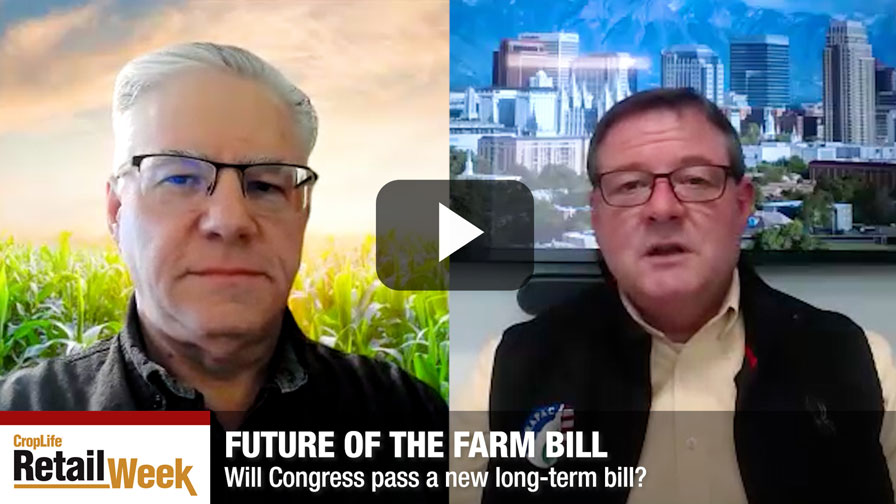
Eric Sfiligoj sits down with Daren Coppock of the Agricultural Retailers Association (ARA) to break down what the end of the government shutdown means for agriculture — including assistance programs and the uncertain future of the Farm Bill. They also preview the 2025 ARA Conference in Salt Lake City in early December.
Can’t see the video? To view it, please accept cookies by clicking the icon in the bottom-right corner of the screen, or click here.
♦ Subscribe to CropLife Retail Week’s Youtube Channel
*Below is a partial and edited transcript:
Eric Sfiligoj
Hello. Welcome to a special edition of CropLife Retail Week. I’m Eric Sfiligoj, editor of CropLife and CropLife IRON, here with a special guest, Daren Coppock from the Agricultural Retailers Association. Daren, welcome to the program.
Daren Coppock
Thanks, Eric. It’s great to be here.
Eric Sfiligoj
Yes, it is. And I think that’s what a lot of folks in the Beltway are saying right now, after the longest government shutdown in history has ended. It’s great for all of us to be here. So we’ll dive right in.
The first question to you: now that the government has reopened, what can agriculture get done that it could not during the last month and a half?
Daren Coppock
There are several things on the to-do list. I think top of that list for all the farm groups is getting assistance into the hands of growers who are still dealing with terrible commodity prices, sticky input prices, lost export markets, etc. And that’s true pretty much across the board for each commodity. They’ve all had some kind of cross to bear.
I think that’s probably top of the list, but there are other things going on. EPA made an announcement today that they’re making the Waters of the United States rule much more flexible. It sounds like they’re going back to what they did in the first Trump administration, which in my view was a very common-sense, straightforward way to handle WOTUS. Hopefully this will be durable and last for us.
We’re still working on a seasonal CDL bill. There are still appropriations that have to be done before next January.
Eric Sfiligoj
And CDL means commercial driver’s license?
Daren Coppock
Yes, commercial driver’s license. It’s a bill a congressman from Kansas was running for us in the House that makes some procedural changes in how you get and keep the seasonal CDL exemption. It should really help us expand the pool of drivers if we can get it passed.
Eric Sfiligoj
Very good. That’s the current to-do list. But now that things are reopened, in a perfect world, what more could agriculture accomplish between now and the end of January?
Daren Coppock
The biggest items on our members’ minds:
Number one is farm-gate economics. We talked about the need for an assistance package and hopefully a five-year farm bill at some point so people have some planning certainty.
Also important is the impact of tariffs—both inbound and outbound. Farmers will end up with higher costs for their imports. The executive order the president just announced lowered a lot of tariffs on fertilizer products, so many of the things we were concerned about will have lower rates.
The issue now is if someone already bought product at the higher rate before the tariff was lowered, what happens to them? They’re now at a competitive disadvantage. That’s not fair. We’ve asked USTR about this. As written, the EO only applies to shipments that start after the cutoff date. Anything done before does not get relief or refund. We’re continuing that conversation because those purchasers now have a problem.
Eric Sfiligoj
What is the cutoff date?
Daren Coppock
I believe it was November 13th, specifically listed in the executive order. We put out communication today to members and the board with the details. There’s a very specific cutoff—if you bought after, you get the lower or no tariff; if you bought before, you paid it and don’t get it back.
Eric Sfiligoj
Interesting. You mentioned the farm bill. Earlier this year at the 2025 Tech Hub Live event in Des Moines, you and I talked about it. Since then, I’ve heard several speakers suggest we may have already seen the last farm bill—back in 2018. The prospects for a new farm bill? When do discussions start, and will we see one or just perpetual extensions?
Daren Coppock
We continue to advocate for a long-term farm bill because it gives farmers, creditors, bankers—everyone—certainty for several years. But the way the farm bill was handled this year raises questions about future bills.
Most programs farmers depend on for direct support—Title I, the commodity title—were extended in the One Big Beautiful Bill Act. SNAP was also adjusted. The things not picked up just got extended at 2025 funding levels in the continuing resolution.
Some agencies were funded for the full fiscal year, but others only through January 30th. So we face the prospect of another shutdown—or at least hard negotiations—to get the remaining appropriations bills done.
For years we’ve relied on a coalition of urban and rural lawmakers to pass a farm bill. Since nutrition programs were reauthorized separately and at lower levels than those interests wanted, keeping that coalition together is tough.
Eric Sfiligoj
I’ve heard that too—that the old coalition no longer exists. Can a new one be formed?
Daren Coppock
There’s always a possibility, but it’s more difficult in these partisan times than 15–20 years ago. There are only eight senators and 25 representatives with direct farm experience—not nearly a majority. So we have to have allies to get a bill passed. The coalition will need to be rebuilt if we’re going to get it done.
Eric Sfiligoj
These topics will definitely be discussed in a couple of weeks. One reason I wanted you on today: we’re getting ready for the annual ARA meeting. And if I’m not mistaken, the cityscape behind you hints at what’s coming. Tell me more about the 2025 ARA Annual Meeting and Conference—high points and new offerings.
Daren Coppock
Yes, that is Salt Lake City behind me. We’re looking forward to being there. This is the first meeting in a northern latitude where you can’t play real golf in early December, so we’re doing Topgolf with heaters. I think it’ll be fun—lots of people who don’t usually play golf can still attend, network, and have a great time.
From the program side:
-
Keynote from Scott “Scrap” Man, a retired Army Green Beret, on leading in low-trust, high-stakes environments.
-
Matt Bacon discussing global weather trends—not just El Niño or La Niña, but longer-term patterns.
-
Dr. Joe Glauber, former USDA chief economist, giving us the real picture of whether current trade policies are helping or hurting agriculture.
Breakouts include:
-
Purdue’s Large Commercial Grower Study
-
ARA’s new LaborLink service for accessing H-2A labor
-
A fertilizer outlook with Josh Linville from StoneX
-
A presentation on generative AI in agriculture
A broad but timely scope of issues.
Eric Sfiligoj
I’m looking forward to the AI discussion—it’s been a buzzword across agriculture for the last 18–20 months. If folks are interested in attending, where can they find more info?
Daren Coppock
Visit our main website at rdc.org and look for the conference section, or add “/conference” to go straight to the site. Pre-registration just closed, so anyone who wants to join can still do so on-site.
Eric Sfiligoj
And for our audience—Topgolf vs. regular golf—I’ve been to several events using Topgolf as the replacement for a golf tournament, and it’s very comfortable. You’re still swinging a club, but you’re not walking all over. I don’t hit very far, so the computer is always telling me to use the driver even when I already am. But it’s a fun experience, and I’d recommend it.
Daren Coppock
It’s also a lot harder to lose a ball at Topgolf than on a real course.
Eric Sfiligoj
Well taken. All right, Daren—it’s time for you to play the game: Fun with Numbers. I’ve got a straight number for you—43.
Is 43:
A) the number of days the government shutdown lasted,
B) the number of CropLife 100 ag retailers that are ARA members,
C) the meaning of life according to Douglas Adams, or
D) the number of hors d’oeuvres I plan to eat at the ARA reception?
Daren Coppock
It could be several of those. But as a Douglas Adams reader, I know the answer to life, the universe, and everything is 42. So it must be the length of the shutdown.
Eric Sfiligoj
Correct. The answer is A. And as for the other options: I know the number of CropLife 100 retailers who are ARA members is higher than 43, and although I love the hors d’oeuvres at ARA events, I’ve never eaten 43 in one sitting—more like 6 to 10.
Daren Coppock
Been there, done that too.
Eric Sfiligoj
All right. Daren, thanks for joining us. We hope everyone attending ARA will say hi to both of us. Thanks for watching this episode of Retail Week, and we’ll see you again next week.
If you have questions or comments about today’s episode, contact us by email, Twitter, or leave a comment below. Your feedback is important, and we’ll try to address your thoughts in next week’s episode. And be sure to subscribe to our YouTube channel.
0
1
5
CropLife Retail Week: ARA’s Daren Coppock on Farm Bill Future and Tariffs





